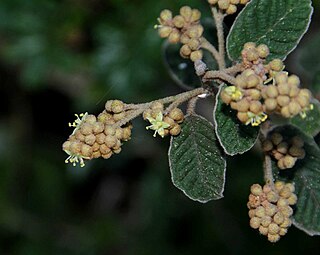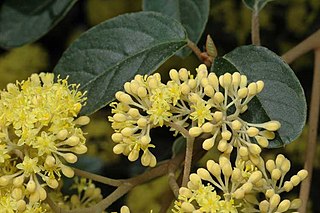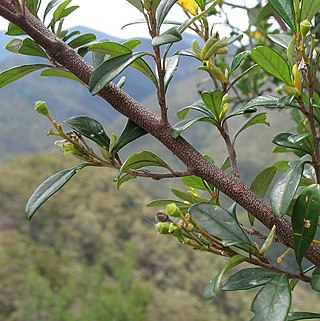
Pomaderris oraria, commonly known as Bassian dogwood, is a species of flowering plant in the family Rhamnaceae and is endemic to south-eastern Australia. It is a compact shrub with hairy branchlets, hairy, elliptic leaves and panicles of hairy, greenish to cream-coloured or crimson-tinged flowers.

Pomaderris paniculosa, commonly known as scurfy pomaderris, is a species of flowering plant in the family Rhamnaceae and is native to Australia and New Zealand. It is a shrub with hairy branchlets, round to elliptic or egg-shaped leaves with the narrower end towards the base and panicles of hairy, cream-coloured to greenish, sometimes crimson-tinged flowers.

Pomaderris apetala is a small tree or large shrub from the family Rhamnaceae, growing in Victoria, New Zealand and Tasmania.

Pomaderris elliptica, commonly known as yellow dogwood or smooth pomaderris, is a species of flowering plant in the family Rhamnaceae and is endemic to south-eastern Australia. It is a shrub with densely hairy branchlets, egg-shaped or elliptic leaves, and pale yellow flowerss.

Pomaderris mediora is a species of flowering plant in the family Rhamnaceae and is endemic to the central coast of New South Wales. It is a low-lying or erect shrub with hairy new growth, narrowly elliptic to lance-shaped leaves with the narrower end towards the base, and panicles of cream-coloured flowers.

Pomaderris andromedifolia is a species of flowering plant in the family Rhamnaceae and is endemic to south-eastern continental Australia. It is a shrub with lance-shaped to elliptic leaves and cream-coloured to yellow flowers.
Pomaderris briagolensis is a species of flowering plant in the family Rhamnaceae and is endemic to Victoria, Australia. It is a shrub with hairy branchlets, egg-shaped or oblong leaves and panicles of white to rust-coloured flowers.
Pomaderris buchanensis is a species of flowering plant in the family Rhamnaceae and is endemic to Victoria, Australia. It is a shrub with densely hairy young stems, narrowly egg-shaped or lance-shaped leaves, and panicles of pale greenish or yellowish flowers.

Pomaderris gilmourii is a species of flowering plant in the family Rhamnaceae and is endemic to Deua National Park in New South Wales. It is a shrub with hairy young stems, egg-shaped to elliptic leaves, and clusters of silvery buds and creamy-yellow flowers.
Pomaderris graniticola is a species of flowering plant in the family Rhamnaceae and is endemic to eastern Australia. It is a shrub or small tree with hairy young stems, lance-shaped to elliptic leaves, and sparse panicles of yellow, white or cream-coloured flowers.
Pomaderris halmaturina, commonly known as Kangaroo Island pomaderris, is a species of flowering plant in the family Rhamnaceae and is endemic to southern continental Australia. It is a shrub with narrowly elliptic to egg-shaped leaves with toothed or wavy edges, and sparse panicles of hairy, yellowish-green flowers.

Pomaderris helianthemifolia is a species of flowering plant in the family Rhamnaceae and is endemic to south-eastern continental Australia. It is a bushy shrub with hairy young stems, narrowly elliptic to lance-shaped leaves with the narrower end towards the base, and small panicles of hairy yellowish flowers.

Pomaderris ligustrina, commonly known as privet pomaderris, is a species of flowering plant in the family Rhamnaceae and is endemic to south-eastern continental Australia. It is a shrub with hairy stems, lance-shaped to narrowly elliptic leaves, and loose clusters of cream-coloured or yellow flowers.
Pomaderris oblongifolia is a species of flowering plant in the family Rhamnaceae and is endemic to eastern Victoria. It is a slender shrub with densely hairy young stems, oblong to narrowly egg-shaped leaves and panicles of hairy, greenish to deep maroon flowers.

Pomaderris phylicifolia, commonly known as narrow-leaf pomaderris, is a species of flowering plant in the family Rhamnaceae and is to south-eastern Australia and New Zealand. It is a slender shrub with hairy stems, narrowly egg-shaped to linear leaves, and small clusters of cream-coloured to yellow flowers.
Pomaderris precaria is a species of flowering plant in the family Rhamnaceae and is endemic to New South Wales. It is a slender shrub with hairy new growth, elliptic to lance-shaped leaves with the narrower end towards the base, and panicles of cream-coloured flowers.

Pomaderris reperta, commonly known as Denman pomaderris, is a species of flowering plant in the family Rhamnaceae and is endemic to a restricted area of New South Wales. It is a shrub with densely rusty-hairy new growth, egg-shaped to elliptic leaves, and dense panicles of cream-coloured flowers.

Pomaderris velutina, commonly known as velvety pomaderris or velvet pomaderris, is a species of flowering plant in the family Rhamnaceae and is endemic to south-eastern continental Australia. It is a slender shrub with rusty-hairy young stems, egg-shaped to oblong or more or less elliptic leaves, and loose panicles of pale yellow flowers.
Pomaderris virgata, commonly known as upright pomaderris, is a species of flowering plant in the family Rhamnaceae and is endemic to south-eastern continental Australia. It is an erect, slender shrub with hairy branchlets, lance-shaped, narrowly elliptic or oblong leaves, and dense panicles of golden-yellow flowers.
Pomaderris viridis is a species of flowering plant in the family Rhamnaceae and is endemic to south-eastern continental Australia. It is a shrub or small tree with hairy young stems, egg-shaped to elliptic leaves, and panicles of cream-coloured to pale yellowish-green flowers.












